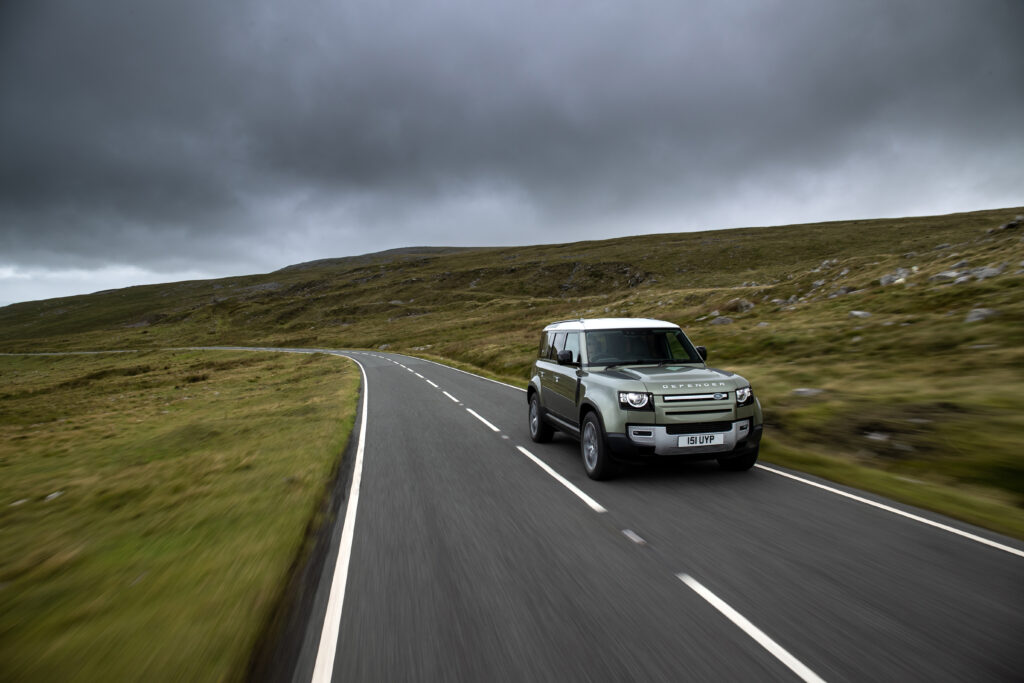Making a splash: The new Land Rover Defender is powerful, expensive, rugged and yet ... utterly luxurious. (Photo: Nick Dimbleby)
ON THE ROAD
We’re having brunch at Finance Minister Tito Mboweni’s favourite spot, just outside Haenertsburg, in the misty mountains of middle Limpopo. He’s on a bench outside, talking animatedly into his phone. This is ostensibly a blueberry farm but the berries on those trees aren’t yet ripe, so the restaurant keeps business ticking along with a simple menu and spectacular food.
In the dirt parking lot, cars from the province mingle with those from Gauteng. This is a new “it” place for weekend tourism. The altitude means it’s cool and the network of dirt forestry roads gives people with oversized SUVs a chance to justify their terrain response systems.
One of those cars is just about the most anticipated car in history — the new Land Rover Defender. It’s what I’m testing. In the parking lot, it’s pulling off an optical illusion. At over 2.2 tonnes, 5m in length and taller than a basketball player it is a massive car. But it’s designed like a pyramid, with the chunky tyres at the bottom jutting out, then everything shrinking on the way up to the roof rack.

Which is to say that it blends in, to an extent. The hard, angular lines of the sides and back do set it apart. This is a design at odds with the all-rounded edges we are so used to. In that regard there is a heavy nod to the iconic Defender that it is replacing, which looked like it had been hacked out of sheet metal, its straight lines ignoring the wind resistance factor.
That Defender was basically a metal tub on big wheels, with a gearbox and drive chain that could go anywhere. The tub meant endless modifications, from fitting machine guns to aid in invasions, to game vehicles and suburban runarounds. Those mods could be done at home, with an angle grinder. Maintenance was similarly simple.
You weren’t sorry for that Defender.
This one is too expensive to treat the same way. The cheapest version is just over R1-million and it goes up to R1.5-million. That price means the Defender 2020 is straying dangerously close to the luxury of its sibling, the Discovery, while not attaining the opulence of the Range Rovers.
The straight lines from the outside are carried into the cabin. In the most expensive version, a sunroof and tiny windows are built into the top corners behind the passenger seats, so everything is bathed in light.
Not that buying the Defender is about logic.
Down the road from Tito’s local, the drought has dried out much of the big dam in the town of Tzaneen. This is a problem. It’s also an opportunity for 4×4 drivers, with a dirt track winding through the now exposed mudflats of the dam.
One driver waves us down before climbing out of his Fortuner to ogle the interior of the Defender. He wants to pose for a photograph — as his entry ticket he pulls up his shirt to show off a Land Rover tattoo. This wasn’t the first such interaction that came with driving this car; buying a Defender is signing on to being part of a community.
And for this community the Defender is hugely important. The latest Discovery has alienated diehards with its dramatic style departure.
Which is where you see the DNA of the original creeping in. While the interior is luxurious, to the point where you can sit back at 120km/h and have the aircon actually improving the quality of the air you breathe while music flows through the cabin, it is also tough.
Hard plastic covers the floors and the insane number of places where you can store phones (there are also plenty of charging points) and other equipment. You can even store things behind the main control screen. Borrowing from the new Jimny and Wrangler, exposed bolts provide a visual cue: this is a working car.
The boot, with its wide door, is similarly clad in material that signals heavy use — everything from cement bags to camping material and kids’ bicycles is welcomed. The boot also houses an air compressor, so should the need arise, you can change your tyre pressure.
You want to be in the Defender. You want to use it, and it can carry seven people in comfort, with the seats in the boot popped up. Those people will enjoy being there, with all the light and absurd leg room.
And they can sit there while driving anywhere. Despite its luxury, the Defender hasn’t lost any of the off-road ability of its predecessor. It is, in fact, a better go-anywhere exponent, thanks to Land Rover’s genius with fitting software that gets the most from hardware.
It has 85 ECUs (electronic control units), air suspension, an aluminium monocoque, a configurable terrain response system that allows you to change almost anything, 900mm wading depth and the ability to trundle up a 45° slope.
This will surely become an icon, and a worthy successor to one of the most important cars ever built.